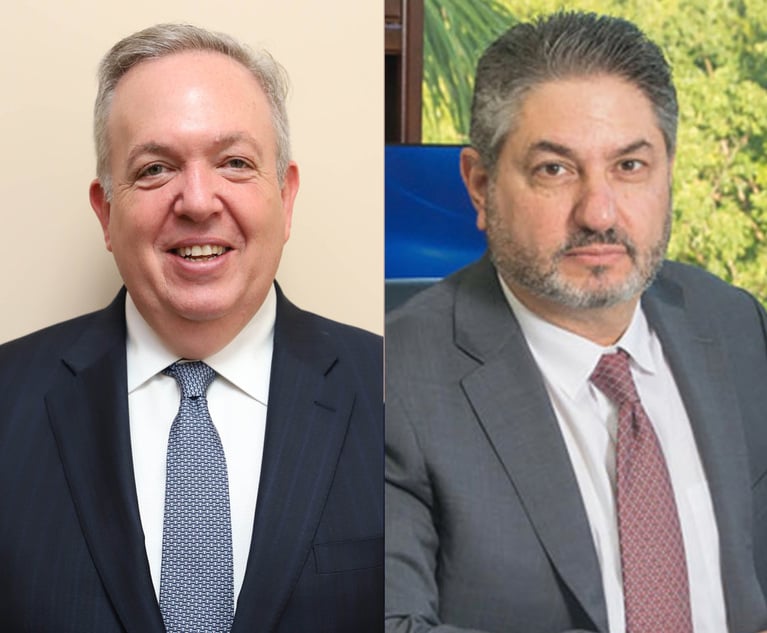The Fed Cut Brings No Clarity, Just Uncertainty
Wednesday arrived with the Fed’s announcement of a 0.25% rate cut. The markets seemed to be disappointed by the meagerness of the cut.
August 09, 2019 at 12:55 PM
5 minute read
 John Metzger, Managing member of the West Palm Beach office of McDonald Hopkins, left, and .Shawn Riley, President of the firm’s Cleveland office.
John Metzger, Managing member of the West Palm Beach office of McDonald Hopkins, left, and .Shawn Riley, President of the firm’s Cleveland office.At the beginning of last week, as the Federal Open Market Committee’s meeting approached and a rate cut appeared likely, we began thinking about the implications of a rate cut for the business community in general and our clients in particular.
For example, at a time when the fundamental economics for real estate ownership are strong, a rate reduction could provide a unique opportunity for owners to refinance loans that are either nearing maturity or may have higher rates. For anyone who had been on the fence, the rate reduction could provide the impetus to refinance or could encourage would-be buyers to complete potential acquisitions or development opportunities that were marginal or even infeasible at current market rates.
Similarly, in a period of low unemployment and growing consumer spending, the American economy does not seem to need a boost. Yet, with a cut, businesses contemplating expansion would find their borrowing costs reduced. To the extent they take advantage of the reduced cost of capital, and make further investments or expand, the Fed will have accomplished its goal.
Then Wednesday arrived with the Fed’s announcement of a 0.25% rate cut. The markets seemed to be disappointed by the meagerness of the cut. Moreover, when Federal Reserve Chairman Jerome Powell addressed what the Fed’s next step would be, he cautioned about assuming more cuts were coming, further confusing the markets. We are left, therefore, wondering whether further rate cuts are on the horizon or whether now is the time to act before rates start increasing.
The Fed’s mixed message—a cut to address concerns about the economy, but a warning that the cut should not be interpreted as a change in direction on rates—may reflect the Fed’s uncertainty about what it needs to do and what it can do. Historically low unemployment in the United States should be driving up inflation and signaling a need for interest-rate increases to cool off the economy. Yet, inflation remains at or below the Fed’s target. Consumer confidence remains high, although consumer debt has reached record levels. And, in contrast with the U.S. economy, which is in its 123rd month of expansion, the European, Japanese and Chinese economies are slowing. Recent cuts in interest rates by the European Central Bank and the Bank of Japan—coupled with clear messages from both that rates could be cut further—puts upward pressure on the U.S. dollar absent corresponding rate cuts by the Fed. Finally, the trade war with China looms large. It is clearly impacting both the U.S. and Chinese economies, albeit unevenly even within each economy.
The mixed economic messages and the external factors impacting the U.S. economy may be more than the Fed’s tool kit can address. The Fed is charged with promoting stable prices, maximum U.S. employment and moderate long-term interest rates. The tools at its disposal— primarily rate cuts or increases and purchasing debt—are not designed to address a possible breakdown in the inflation/unemployment relationship, conflicting actions by other central banks or the macro-economic impact of a trade war. In other words, if the Fed cuts rates by 25 basis points or raises it by 25 basis points, could the result be more of a psychological impact than a true economic impact because there is so much going on in the world that it cannot control?
What the presidents of the United States and China decide to do during this trade war is having a much greater impact on the economy than 25 basis points. The farmer in Polk County in Florida doesn’t care that he can borrow or refinance for less today. He is wondering where he will sell orange juice. The steel processor in Cuyahoga County in Ohio isn’t impacted by 25 basis points because the tariffs have just made his products so much cheaper to sell and he can raise his prices dramatically.
So, what does this mean for our clients? Unfortunately, in a word: uncertainty. Acting now and taking advantage of lower rates will look wise in hindsight if the U.S. economy continues to expand and interest rates rise (or do not decline further). Conversely, if rates do decline further and the U.S. economy enters a recession, additional debt or higher rate debt will be viewed as a mistake.
We are in unchartered waters. Many of us who have been advising clients on a wide range of restructuring issues since the 1980s have seen so many different ups and downs. We have never, however, experienced anything like this 10-year expansion with a rock-bottom unemployment and minimal inflation. And yet, there is such a sense of foreboding. The truth is that no one knows exactly what is coming next, including the Fed.
John T. Metzger is managing member of the West Palm Beach office of McDonald Hopkins. Shawn M. Riley is the firm’s president.
This content has been archived. It is available through our partners, LexisNexis® and Bloomberg Law.
To view this content, please continue to their sites.
Not a Lexis Subscriber?
Subscribe Now
Not a Bloomberg Law Subscriber?
Subscribe Now
NOT FOR REPRINT
© 2025 ALM Global, LLC, All Rights Reserved. Request academic re-use from www.copyright.com. All other uses, submit a request to [email protected]. For more information visit Asset & Logo Licensing.
You Might Like
View All
SEC Whistleblower Program: What to Expect Under the Trump Administration
6 minute read
Turning the Shock of a January Marital Split Into Effective Strategies for Your Well-Being
5 minute read

Trending Issues in Florida Construction Law That Attorneys Need to Be Aware Of
6 minute readTrending Stories
- 1New York Judge Steps Down After Conviction for Intoxicated Driving
- 2Keys to Maximizing Efficiency (and Vibes) When Navigating International Trade Compliance Crosschecks
- 3Houston Law Firm Files $250K Breach of Contract Suit Against 2 Former Lawyers
- 4The Week in Data Feb. 3: A Look at Legal Industry Trends by the Numbers
- 5Mass Tort Cases: Challenges for Plaintiff’s and Defense Counsel
Who Got The Work
J. Brugh Lower of Gibbons has entered an appearance for industrial equipment supplier Devco Corporation in a pending trademark infringement lawsuit. The suit, accusing the defendant of selling knock-off Graco products, was filed Dec. 18 in New Jersey District Court by Rivkin Radler on behalf of Graco Inc. and Graco Minnesota. The case, assigned to U.S. District Judge Zahid N. Quraishi, is 3:24-cv-11294, Graco Inc. et al v. Devco Corporation.
Who Got The Work
Rebecca Maller-Stein and Kent A. Yalowitz of Arnold & Porter Kaye Scholer have entered their appearances for Hanaco Venture Capital and its executives, Lior Prosor and David Frankel, in a pending securities lawsuit. The action, filed on Dec. 24 in New York Southern District Court by Zell, Aron & Co. on behalf of Goldeneye Advisors, accuses the defendants of negligently and fraudulently managing the plaintiff's $1 million investment. The case, assigned to U.S. District Judge Vernon S. Broderick, is 1:24-cv-09918, Goldeneye Advisors, LLC v. Hanaco Venture Capital, Ltd. et al.
Who Got The Work
Attorneys from A&O Shearman has stepped in as defense counsel for Toronto-Dominion Bank and other defendants in a pending securities class action. The suit, filed Dec. 11 in New York Southern District Court by Bleichmar Fonti & Auld, accuses the defendants of concealing the bank's 'pervasive' deficiencies in regards to its compliance with the Bank Secrecy Act and the quality of its anti-money laundering controls. The case, assigned to U.S. District Judge Arun Subramanian, is 1:24-cv-09445, Gonzalez v. The Toronto-Dominion Bank et al.
Who Got The Work
Crown Castle International, a Pennsylvania company providing shared communications infrastructure, has turned to Luke D. Wolf of Gordon Rees Scully Mansukhani to fend off a pending breach-of-contract lawsuit. The court action, filed Nov. 25 in Michigan Eastern District Court by Hooper Hathaway PC on behalf of The Town Residences LLC, accuses Crown Castle of failing to transfer approximately $30,000 in utility payments from T-Mobile in breach of a roof-top lease and assignment agreement. The case, assigned to U.S. District Judge Susan K. Declercq, is 2:24-cv-13131, The Town Residences LLC v. T-Mobile US, Inc. et al.
Who Got The Work
Wilfred P. Coronato and Daniel M. Schwartz of McCarter & English have stepped in as defense counsel to Electrolux Home Products Inc. in a pending product liability lawsuit. The court action, filed Nov. 26 in New York Eastern District Court by Poulos Lopiccolo PC and Nagel Rice LLP on behalf of David Stern, alleges that the defendant's refrigerators’ drawers and shelving repeatedly break and fall apart within months after purchase. The case, assigned to U.S. District Judge Joan M. Azrack, is 2:24-cv-08204, Stern v. Electrolux Home Products, Inc.
Featured Firms
Law Offices of Gary Martin Hays & Associates, P.C.
(470) 294-1674
Law Offices of Mark E. Salomone
(857) 444-6468
Smith & Hassler
(713) 739-1250






